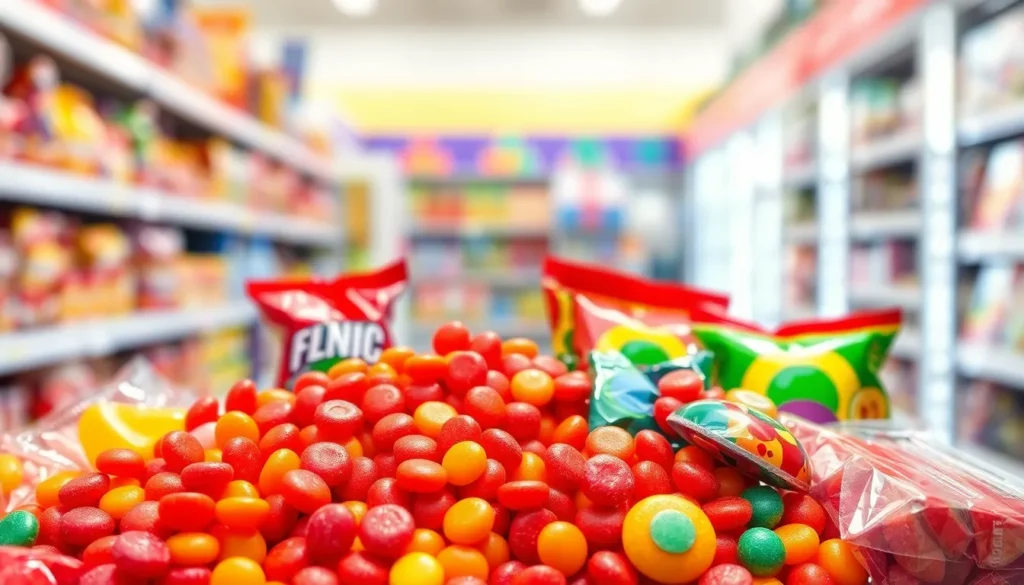Table of Contents
ToggleRed Dye 40, the vibrant food coloring that brightens everything from candy to cereals, has a reputation that’s as colorful as its hue. But is it a harmless fun-factory or a villain lurking in the pantry? With growing concerns over health effects and potential bans, it’s time to dive into this juicy debate.
Imagine biting into a bright red gummy bear, only to realize it might be more than just a sweet treat. The question of whether Red Dye 40 is banned in certain regions has sparked conversations among health enthusiasts and snack lovers alike. So, let’s unravel the mystery behind this eye-catching dye and discover if it’s still making the cut on grocery store shelves or if it’s been sent packing.
Overview of Red Dye 40
Red Dye 40, also known as Allura Red AC, is a synthetic food coloring derived from petroleum. This dye appears in numerous products, including candies, cereals, drinks, and processed foods. By providing a bright red hue, it enhances visual appeal and increases marketability.
Regulatory agencies in various countries, including the FDA, have deemed Red Dye 40 safe for consumption in approved amounts. Specific limits exist to govern its use based on factors like age and overall diet. Countries in Europe have stricter guidelines, requiring warning labels on products containing this dye due to potential behavioral effects in children.
Potential side effects related to Red Dye 40 include allergies and hyperactivity in sensitive individuals. Some studies suggest a correlation between this dye and hyperactive behavior, particularly in children. Regulations reflect these concerns, prompting discussions about consumer awareness and labeling practices.
Availability remains widespread in the United States. Grocery stores stock a variety of items containing Red Dye 40, despite ongoing debates over its safety. In contrast, certain countries in Europe have implemented bans or restrictions on the use of artificial dyes, which include Red Dye 40, emphasizing the differing approaches to food safety.
Health advocates often call for clearer labeling, encouraging consumers to remain informed about the ingredients in their foods. While Red Dye 40 is legally permitted in many places, scrutiny continues, particularly from consumers looking for natural or healthier alternatives.
Regulatory Status of Red Dye 40

Red Dye 40, commonly used in food products, faces varied regulatory approaches worldwide. Some countries impose strict regulations, while others accept the dye within certain limits.
Global Regulations
Different nations enforce diverse regulations regarding Red Dye 40. In the European Union, for instance, enhanced scrutiny leads to mandatory warning labels on products containing artificial colors. Several countries, including Norway and Finland, restrict its use altogether. Advocates for food safety push for comprehensive regulations to reduce potential health risks. Many importers need to adhere to stricter guidelines when distributing products containing the dye across borders.
U.S. Regulations
In the United States, the Food and Drug Administration (FDA) considers Red Dye 40 safe for consumption when used within established limits. Approval comes after extensive reviews, ensuring clarity in food safety assessments. Although widely available, manufacturers must follow specific labeling practices, especially when health claims arise. Consumers in the U.S. often remain unaware of potential sensitivities related to the dye. Calls for transparency in labeling continue as health advocates emphasize informed dietary choices.
Health Concerns Related to Red Dye 40
Red Dye 40 raises notable health concerns among consumers. Safety perceptions vary, particularly around allergic reactions and potential behavioral effects in children.
Allergic Reactions
Allergic reactions to Red Dye 40 occur in some individuals, particularly those with sensitivities. Symptoms may include hives, itching, and stomach upset. Research supports the link between artificial colors and allergies, indicating that individuals with a history of allergies may be vulnerable to adverse reactions. The prevalence of these reactions, while relatively low, emphasizes the importance of consumer awareness regarding labeled ingredients, especially for those with known sensitivities.
Potential Behavioral Effects
Potential behavioral effects of Red Dye 40 garner significant attention from parents and health professionals. Many studies suggest a correlation between artificial food colors and hyperactivity in sensitive children. The FDA acknowledges these concerns but maintains that Red Dye 40 is safe when consumed in moderation. Meanwhile, some countries have taken precautionary measures, requiring warning labels on products that contain artificial colors. Awareness of these behavioral concerns is crucial for parents making informed dietary choices for their children.
Alternatives to Red Dye 40
Natural colorants provide a viable option for those seeking to avoid Red Dye 40. Beet juice serves as one popular alternative, offering a deep red hue derived from beets. Another option, anthocyanins, sourced from blueberries and blackberries, imparts vibrant purple-red shades to foods.
Turmeric, known for its bright yellow color, can create orange tones when mixed with other ingredients. Many brands utilize paprika extract, which delivers a red to orange color while imparting a subtle flavor enhancement. Carrot juice also provides a natural means to achieve orange coloration, along with added nutritional benefits.
Fruit and vegetable extracts not only contribute visual appeal but also deliver health benefits. Spinach, for instance, provides green coloring while offering nutrients and antioxidants. Using such natural sources resonates with health-conscious consumers prioritizing clean labels.
Organic food brands frequently opt for natural colorants to attract wary shoppers. Many people prefer products with fewer synthetic additives due to rising awareness of potential health implications. Innovative food manufacturers explore these alternatives to enhance product appeal while addressing consumer demand for transparency.
Some companies combine multiple natural dyes to achieve desired shade accuracy. Blending these extracts enables manufacturers to create a broader spectrum of colors without relying on synthetic options. Increased demand for plant-based ingredients further drives this shift in food coloring practices.
Research suggests these natural alternatives may not only satisfy aesthetic preferences but also contribute to overall product quality. They often align better with consumer trends toward health, sustainability, and clean eating. As awareness grows, it’s likely that the use of natural colors will continue to rise in popularity.
Red Dye 40 remains a contentious topic in the realm of food safety and consumer health. While regulatory bodies like the FDA deem it safe within certain limits, ongoing debates about its effects on sensitive individuals persist. The differences in regulations across countries highlight the need for greater consumer awareness and transparency in labeling. As health-conscious consumers seek alternatives, the rise of natural colorants signifies a shift towards healthier options. This evolving landscape reflects a growing demand for safer food products that align with consumer values.







